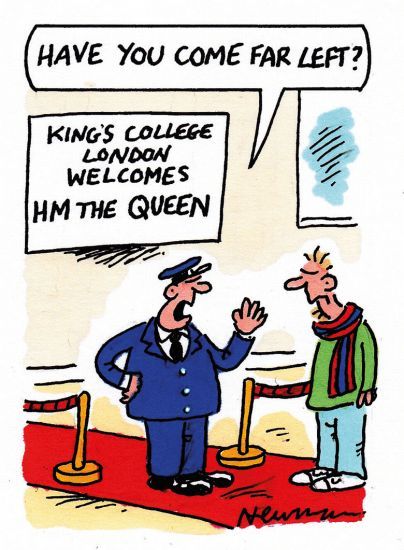
The Queen’s visit to open King’s College London’s new teaching building did not generate the usual positive headlines after several students claimed that they had been banned from campus on account of their political activism, The Guardian reported on 22 March. Ten students say that they were unable to access the university’s Strand campus on 19 March – with one almost missing a graded presentation as a result – after they were singled out as troublemakers for their campaigns to end staff outsourcing. One student was even blocked by King’s security system while using his pass at the Denmark Hill campus several miles away from Her Majesty’s visit, it was claimed. King’s has promised an independent review of its procedures, although the affected students said that there was “no faith” in the probe given the “zero acknowledgement” by the university of the concerns raised. With King’s becoming a popular venue for royal events – the Duchess of Sussex has visited several times in recent months – students will be keen to know that such lockouts will not be a regular occurrence.
Of course Jordan Peterson wasn’t going to take the withdrawal of his visiting fellowship at the University of Cambridge lying down. After the Faculty of Divinity announced that he wouldn’t be spending autumn on the edge of the Fens after all, Professor Peterson accused it of “kowtowing to an ill-informed, ignorant and ideologically addled mob”. Professor Peterson, professor of psychology at the University of Toronto, has courted controversy for his views on transgender rights, gender and race. Cambridge said that the university was “an inclusive environment, and we expect all our staff and visitors to uphold our principles. There is no place here for anyone who cannot.” It sounds as if Professor Peterson has gone off Cambridge now, anyway. “I think that it is no bloody wonder that the faith is declining (and with it, the values of the West, as it fragments) with cowards and mountebanks of the sort who manifested themselves today at the helm,” he wrote.
Academics in the UK have to wait seven long years between each research excellence framework. If that’s too long, head to Australia, where results of the Excellence in Research for Australia assessment are released every three or four years. The latest results, published on 27 March, show “significant improvement” in the standard of scholarship Down Under, according to the Australian Research Council. Research in more than half the broad disciplines assessed – 57 per cent – was rated as being above or well above “world standard”, compared with 46 per cent in the previous set of results, published in 2015. Mathematical sciences, medical and health sciences, and technology were identified as the country’s strongest disciplines.
Donald Trump’s fiery threats to withdraw federal funding unless colleges upheld free speech on campus caused a stir in US higher education a few weeks back. But the executive order promised by the US president, announced on 21 March, did not perhaps live up to his rhetoric, demanding, in somewhat bland fashion, that federal agencies “take appropriate steps” to “promote free inquiry” on college campuses. Nor did it give any details on how that would happen. Despite the lack of enforcement powers, Mr Trump hosted an elaborate executive order signing ceremony, at which he invited remarks by three students who each described emotional confrontations as they promoted conservative causes on their campuses. Mr Trump urged them to continue “challenging rigid, far-left ideology”.
Has the greatest whodunnit of all time finally been solved? Some 130 years after the horrific murders attributed to Jack the Ripper ceased, forensic scientists at Liverpool John Moores University have released evidence to suggest that the serial killer was Aaron Kosminski, a Polish-born barber who lived in London’s East End at the time of the Whitechapel murders of 1888, The Times reported. Using a blood-spattered shawl found next to one of the five mutilated victims, experts identified that it had semen on it from Mr Kosminski – a match made possible using mitochondrial DNA taken from his living relatives. But the sensational breakthrough, reported in the peer-reviewed Journal of Forensic Sciences, has not convinced everyone: some have questioned why the authors have failed to publish the DNA sequencing they based their claims on, with one sceptic labelling it “bad science.”
Register to continue
Why register?
- Registration is free and only takes a moment
- Once registered, you can read 3 articles a month
- Sign up for our newsletter
Subscribe
Or subscribe for unlimited access to:
- Unlimited access to news, views, insights & reviews
- Digital editions
- Digital access to THE’s university and college rankings analysis
Already registered or a current subscriber? Login





